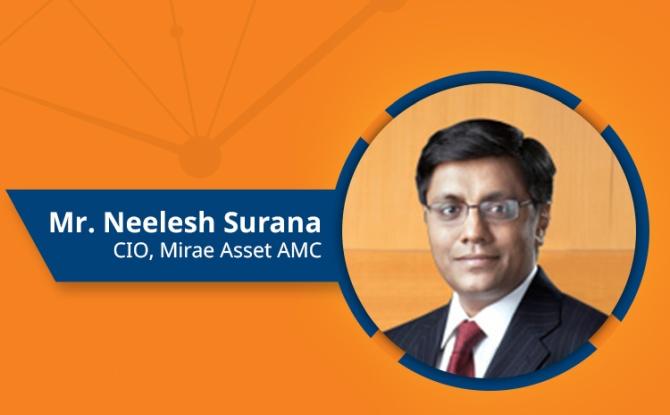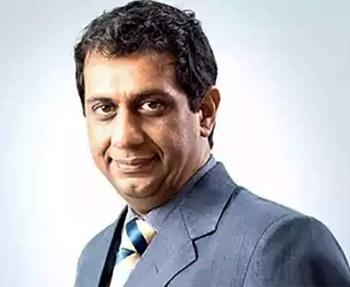‘There is no need to do anything, let your SIPs get deducted every month, and stick to your allocation between equity, fixed income and emergency funds and your risk covers.’
Indian equities markets have largely remained strong for more than a year driven by loose liquidity by the global central bankers.
As markets continued to surge, foreign as well as domestic investors continued to pump in money into Indian stocks.
In last month’s Business Standard CIO Round Table on markets, the country’s leading money managers said that investors should moderate return expectations from equities going forward and continue to hold funds for a longer duration.
The participants included Prashant Jain, executive director and chief investment officer, HDFC Asset Management Company; S Naren, ED and CIO, ICICI Prudential Asset Management Company; Lakshmi Iyer, CIO (debt) and head-products, Kotak Mahindra Asset Management Company; Neelesh Surana, CIO, Mirae Asset Investment Managers (India); Manish Gunwani, CIO-equity investments, Nippon Life India Asset Management; Rajeev Thakkar, CIO and director, PPFAS Asset Management.
Given the current situation in the market, what should one do — buy, sell or hold?
Manish Gunwani
You can be very bearish optically as price-to-earnings (P/E) is very high.
The credit spreads globally and domestically are low.
In the US bond market, the five- to 10-year inflation expectations are still above 2 per cent. And still people are buying bonds at 1.5 per cent.
Now, this can only mean two things. One, that the bond market is expecting a big recession going ahead.
The other explanation, which I think is a bit scary for value investors is that these negative real rates are going to stay longer than we all thought.
And if that is true, you can’t afford not to be in equities.
You will get top line growth by inflation, due to operating and financial leverage, you will get good earnings growth.
S Naren
The entire lever is now with the central banks.
In many interviews, I’ve called it a global central bank bull market. We don’t hold the key.
The key is held by the global central banks that have pumped in $25,000 billion of money into the market.
For every inflation number, if they decide that it is transitory, then we are going to have a big bull run.
I don’t think there are problems locally. But we certainly fear that global central banks have pumped too much money and that has caused investor exuberance across the world and that risk can also cause a correction.
Neelesh Surana
On your specific question on between buy, sell and hold, I would remain in the deep buy camp.
I would say buy within well-defined allocation.
The view is constructive on equities primarily coming from the fact that earnings outlook has improved significantly, and the cost of capital is also low.
The near-term valuations may not be reasonable, or at least above normal, but on a longer term it is still okay.
The longer-term stories remain strong as a lot of reforms have taken place in the last four-five years.
But from the investor’s perspective, one should come with a longer time frame of, say, three-five years.
Also, one should come with a slightly more graded sort of returns expectation.
Prashant Jain
I think valuations in equities are fair, they could be slightly expensive if you think near term.
The bulk of the money over the next few years should be made by earnings growth, and very little from P/E multiples moving up.
Regarding your question on buy, sell or hold, I don’t think a simple answer like that is possible. Because whether you buy, sell or hold depends on your time horizon and risk appetite.
But let me just add one last point: In the last 40-odd years of Sensex history, the Sensex has moved up from 100 to 60,000, and many times, the multiples have been where they are today.
Rajeev Thakkar
Irrespective of what I’m going to say next, my recommendation to people is that if you are like me, where retirement is more than 10 years away, and if you are having long-term goals, just stick to your asset allocation.
There is no need to do anything, let your SIPs (systematic investment plans) get deducted every month, and stick to your allocation between equity, fixed income and emergency funds and your risk covers.
In equities, I think there are pockets where a serious amount of money is going to be lost.
And especially in the frothy space where companies are coming out for listings.
At the same time there are pockets in the market, which can be safely held. And there are pockets where one can buy.
Debt funds and particularly credit risk funds have seen various problems due to the downgrades and defaults in the last few years. Do you think everything is behind us?
Naren
I must say that thanks to the good processes and credit that we had, in that cycle, we had no problems.
And right now, credit issues are clearly not something that the system itself has at this point of time.
And Sebi (Securities and Exchange Board of India) also took a lot of steps to ensure that each of us have a lot of Gilts in each of the portfolios.
So, I would say the system has become very safe relative to what it was.
But if you look at it from a different angle, does the country require only triple and double ‘A’ debt to be issued? The reality is there are risks today in the equity IPO (initial public offering) markets, not in the credit markets.
Thakkar
The problems of the debt market have been put behind us by moving to sovereigns and triple ‘A’ or at best double ‘A’.
In the debt space, the lower rated market is not there and the problem that we face in India is that we don’t have a buyer in the stressed asset space.
If we look at something like what is happening in China, with the real estate companies in trouble and a company like Evergrande, having its bonds falling, defaulting and bonds falling in price, and you have someone like Goldman Sachs stepping in and trying to buy distressed paper at low rates and aiming to make some money over there.
But in India, what happens is if a company defaults or there’s a risk of a severe downgrade, the paper simply becomes unsellable.
But longer term, if we want to fund the small and medium enterprises and some of the lower-rated players and allow them to grow, we need to find some solutions for corporate credit events where either there’s a default or there’s a ratings downgrade.
Lakshmi Iyer
Clearly, there has been a lot of comfort, that’s reflected in the fact that the AUMs (assets under management) in the credit category also have been growing.
And I think that capital gains from fixed income is not going to be a primary driver for returns.
So probably in the recent past, accrual assets have started finding a fancy in an investor’s portfolio and with the right reasons.
The IPO market is hot, and we have seen a large number of companies coming out with an IPO. How would you have compared between value versus growth and given the situation what is your advice to investors?
Thakkar
We all have seen the US markets where some of the innovative companies of the 1990s have given stupendous returns to investors and in the early days, they were not making too much profit, or they were not at all.
They were probably in losses and for many years.
Still investors have done well by investing in those.
Let’s say Amazon from the 1990s. If one had bought Amazon on listing, one would be sitting on hefty gains today.
But on an average, every company may not turn out to be an Amazon.
I would urge investors to look at some of the listed companies, which are so-called old economy companies, but which are doing precisely the same thing that some of the IPOs are doing in different pockets of their area of operations.
You could have a food delivery company coming out with an IPO at the same time, you could have an existing listed company, which gives you food delivery at home by ordering through their apps.
Or you could have a Fintech company offering payments.
And you could have some of the existing listed players already offering some of those facilities.
So don’t just look at the newer companies, also look at some of the listed companies.
Naren
The point is that, you know, having seen IPO cycles for a long period of time, in IPOs the seller is always well-informed.
And whenever we have seen big IPO cycles, whether it is in 1994-1995, or 1999, or 2007 and at the end of the cycle you do see overvaluation.
And it is a ‘buyer beware’ situation. I do agree with most of the other participants that the overall market is not bizarrely overvalued at this point of time.
I believe that investors missed one of two IPOs, but by and large IPOs did not deliver returns for investors.
The number of companies disappearing after doing IPO, particularly in the 1990s was amazing.
Of course regulations have improved, Sebi has come in, and various other things have happened.
The investment bankers, which are selling are very smart investors even the sellers are very smart.
But (retail) investors must practise investment allocation and prevent risks at this point of time.
Surana
The value versus growth template, I would over time learn the hard way and go with what Charlie Munger mentioned, that growth has to be a subset of value.
Traditionally, value investing like Ben Graham or Phil Fisher doesn’t work in India because it’s a growing market.
Similarly, on the other side, overpaying for the growth is also not advisable.
The point is that this discussion is coming because of new age IPOs, but as you see in our portfolio or mutual funds’ portfolio all these businesses are hardly 2-3 per cent or less than that.
There are pockets that are growth-oriented businesses, which are available at reasonable value.
The media attention is on new age business, but that doesn’t represent the markets.
Iyer
Value in fixed income will depend on what kind of category or segment you are holding.
There is never a debate, at least from a bond market, with respect to value or growth.
Yes, but as I said, categories within fixed income which definitely offer value in the current space are between ‘AAA’ bonds and SDLs (state development loans).
We believe state loans are the underdogs and they are under-owned by FPIs (foreign portfolio investors) and from the Indian investor perspective.
Gunwani
Things are more complex than what we make out to be. If you see how the industries have evolved, it has a lot to do with the management.
So, the challenge is not to go by easy analysis, the payoff of picking two-three management out of 10 is so huge that I would not brush that off.
If you keep your heads down and do the hard work, you will get maybe the next Google, Amazon or the next BlackRock. I think it is all about management.
Jain
I just feel these are cycles of the markets and even in the past we have seen pockets of excess, deep value and good value.
Things change over the period and there is nothing new or out of place that is happening in the market this time around.
The sectors that are expensive or cheap keep on changing. I would say that it is a free market and everyone with their own wisdom will construct their portfolios.
Which are the sectors one should look at in the current market?
Jain
I am a believer in all strong sustainable businesses that offer reasonable valuations.
In my judgement I see value in corporate banks and PSUs (public sector undertakings).
I don’t distinguish between PSU or private companies. There are good and bad companies in both spaces.
As the economy does well, PSUs should also perform better.
Apart from that I see reasonable value in capital spending and some value in companies in the power sector.
Thakkar
The US technology space has been very attractive compared to the Indian high growth companies, which includes new age listing or some of the consumer names.
Consumer names in India are quoting at extremely high valuation multiples.
While some of the large US tech companies are trading at anywhere between 20 and 25 earnings multiples.
They have a very robust business model and some of the newer business they have not monetised yet.
Surana
What we see as a longer-term allocation is to have two-thirds to three-fourths in large-cap and remaining in mid-cap.
In India, large-cap companies are also growing franchises and some of them have better returns ratios.
So, it makes sense to have higher allocation to large-caps.
Second on the sectoral preference, consumer discretionary, auto parts, insurance and healthcare are some sectors that looking attractive now.
Gunwani
Given that we are living in a high-inflation, low-rate world, we have to buy financial, operating leverage and most of the domestic cyclicals.
I see value in non-banking financial companies, cement and real estate.
Only disclaimer I give is that the moment you see the current account deficit going to 3 per cent, you must change your stand.
There has been a series of regulations like investing 20 per cent in its own schemes and many others. Do you think it’s the time to relook at those regulations?
Naren
We would always be happy with loose regulations. But you know when you work for ICICI Mutual Fund, you get the ability to touch people from Kashmir to Kanyakumari and from Guwahati to Dwarka.
Managing money for millions of people has been phenomenal for us. When I joined ICICI MF, we used to manage Rs 2,000 crore (Rs 20 billion) of equity money and maybe Rs 10,000 crore (Rs 100 billion) of overall AUM.
From there, we have reached Rs 4.60 trillion, and that number can even reach Rs 10 trillion very easily.
We would request through the media that let us get easier regulations and we will be happy.
Gunwani
We are big asset managers like McDonald’s. There is always a Thai or Lebanese restaurant, which will have its own followings.
So, if you are a McDonald’s, you have to live with different regulations compared to other cuisines. This is just part of the landscape.
Surana
It is a just the job of fiduciary responsibility.
I mean ideally one could have some relaxed regulations. Having said that, the overall context is fine.
Iyer
I want to add that they increase our salary or give us interest free loans (regarding the compensation circular).
As far as phone recording is concerned everything that happens in market hours and off market hours, which is business related, is on the right course.
Thakkar
Broadly, the regulations have been customer friendly.
While it irritates for some time, it results in the industry’s growth. But sometimes the regulations should be principle-based rather than rule-based.
To give an example, skin in the game or the compensation circular, I have been putting a sizable amount in my own schemes for almost a decade now.
But the new regulation is more rule-based rather than principle-based where we will be forced to put money in a liquid fund which will give us returns of 3-odd per cent and it will be locked in for three years.
There should be a shift to principle-based rules where we can protect investors rather than having very strict rules.
Jain
There are always two sides to the coins. Regarding the 20 per cent investments: I only hope that management increases our salary so that no one can complain.
Feature Presentation: Rajesh Alva/Rediff.com
Source: Read Full Article





